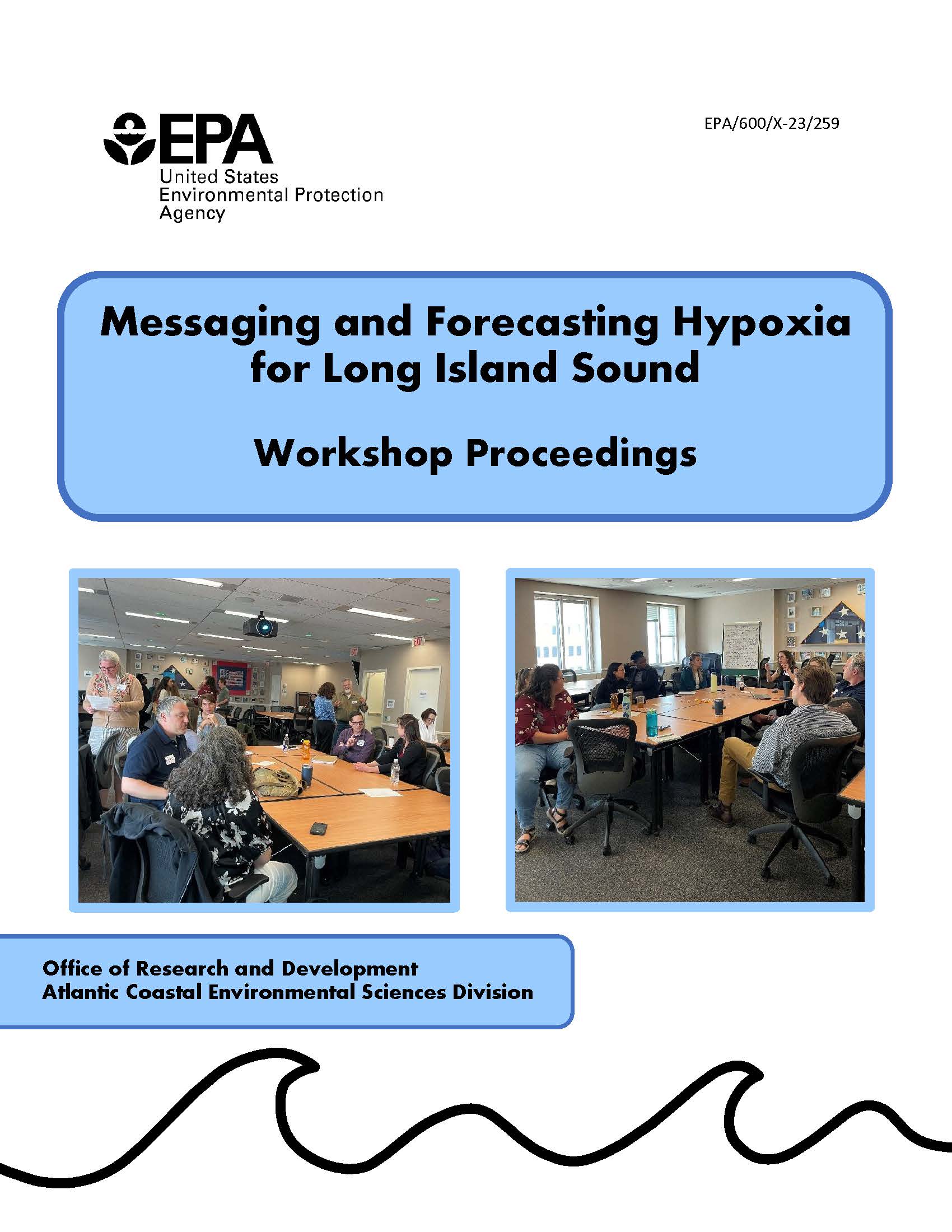
On May 23, 2023, the EPA Office of Research and Development with the EPA Region 2 office held a workshop in New York City to discuss how to develop effective messaging on the impact of hypoxia (low dissolved oxygen in water bodies) in Long Island Sound. As part of the proceedings, scientists, resource managers, science communicators, outreach coordinators, and local environmentalists identified engagement approaches to use hypoxia forecasting in improving public awareness about hypoxia in Long Island Sound. The Messaging and Forecasting Hypoxia for Long Island Sound Workshop shared information on the early work on the hypoxia forecasting model for Long Island Sound and elicited perspectives of attendees on key audiences and design for related communication products. The workshop proceedings presents the motivation for the workshop, the structure of the event, and the findings from the day’s discussions. It’s available as a PDF document.
Up to $1.5 million available to build capacity in under-resourced Connecticut and New York communities to help protect and restore Long Island Sound
This news release was prepared by Restore America’s Estuaries, and initially appeared on its website on Sept. 27, 2023. For more information about the grant program, visit www.estuaries.org/liscif or contact Shahela Begum, LISCIF Program Director, at sbegum@estuaries.org.
For Immediate Release: Sept 27, 2023
Contact: Rob Shane – rshane@estuaries.org / Shahela Begum – sbegum@estuaries.org
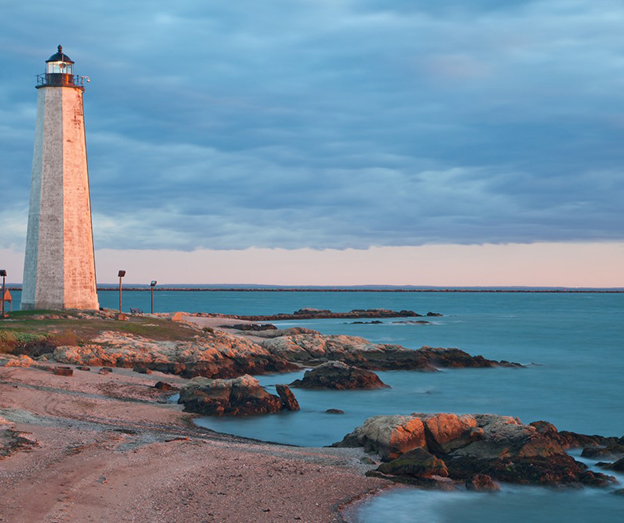
In partnership with the Long Island Sound Study (LISS) and the U.S. Environmental Protection Agency (EPA), Restore America’s Estuaries (RAE) is announcing a request for applications (RFA) for the Long Island Sound Community Impact Fund (LISCIF). The purpose of the LISCIF is to provide technical and financial assistance to communities with environmental justice concerns and improve the quality and accessibility of the Long Island Sound. LISCIF intends to distribute up to $1.5 million in competitive grants in the first round of funding. RAE will also facilitate annual peer-to-peer learning and information sharing meetings among awardees and key stakeholders in the region.
“Innovative programs like the Long Island Sound Community Impact Fund are essential for continued protection and restoration of the Long Island Sound – and for confronting longstanding inequities by dedicating environmental resources to local neighborhoods that need them most,” said EPA New England Regional Administrator David W. Cash. “I look forward to celebrating the positive impacts of these projects made possible through historic funding from the Bipartisan Infrastructure Law and with the vision and support of Restore America’s Estuaries.”
“Long Island Sound is a national treasure with critical environmental, cultural and economic importance,” said EPA Region 2 Administrator Lisa F. Garcia. “With the Long Island Sound Community Impact Fund we are advancing environmental justice, as well as restoring and preserving our precious Long Island Sound for communities along the Sound in New York and Connecticut.
The competitive grant program will focus on activities that address challenges and opportunities facing overburdened and underserved communities in Connecticut and New York that affect Long Island Sound. Eligible projects will be community driven, help implement the Long Island Sound Comprehensive Conservation and Management Plan, and address challenges and risks faced by communities experiencing disproportionate environmental injustices.
LISCIF’s grantmaking process utilizes a two-step application process: a Letter of Intent (LOI), followed by a limited number of invited, full proposals. LOIs are due by December 1, 2023. Upon selection and invitation, full proposals are due by March 15, 2024. For more information and access to the RFA, please go to LISCIF24 RFA Page. Webinars and technical assistance opportunities for LISCIF will be available in October and the upcoming months.
Funding is available for projects that:
- Result in quantifiable pollutant prevention or reduction;
- Restore habitat within the “Important Coastal Habitat Types” targeted by LISS;
- Foster diverse, abundant populations of fish, birds, and wildlife.
- Increase public engagement, knowledge, and stewardship;
- Enhance community resilience and sustainability;
- Plan and design water quality, habitat restoration, and resilience implementation;
- Increase community-based science;
- Improve data management and accessibility for community action; and
- Other similar activities that the applicant proposes, and EPA approves, that are consistent with section 119 of the Clean Water Act.
RAE will host two informational webinars for potential applicants to learn about the program, walk through the application process, and be able to ask questions of the program director. The first will be October 10 at 10 AM ET and the second will be October 17 at 2 PM ET. Click the respective links to register.
Funding for LISCIF is provided by EPA through the Bipartisan Infrastructure Law and will help meet the goals of the Justice40 Initiative which calls for, “40% of the overall benefits of these Federal investments flow to disadvantaged communities that are marginalized, underserved, and overburdened by pollution”. The EPA defines environmental justice as, “the fair treatment and meaningful involvement of all people regardless of race, color, national origin, or income, with respect to the development, implementation, and enforcement of environmental laws, regulations, and policies. This goal will be achieved when everyone enjoys: (1) The same degree or protection from environmental and health hazards, and (2) Equal access to the decision-making process to have a healthy environment in which to live, learn, and work”.
For more information, please visit www.estuaries.org/liscif or contact Shahela Begum, LISCIF Program Director, at sbegum@estuaries.org.
For more information on the Long Island Sound Study, please visit: https://longislandsoundstudy.net/
Research along Connecticut coast uses “warming chambers” to heat plants to simulate the salt marsh environment in the coming decades
By Juanita Asapokhai
A coastal habitat teeming with wading birds, small fish, fiddler crabs, and more aquatic life. A “sink” for carbon absorbed from the atmosphere, lessening the effects of global warming. A shield for coastlines battered by harsh waters, and a buffer for coastal homes against storm damage.
These are some of the roles that salt marshes play within Long Island Sound’s ecosystem. Salt marshes, or tidal marshes, are defined in a CT Sea Grant manual as “the green belts and meadows we see between the upland and the tidal waters of the Sound’s bays, coves, and estuaries.” Globally, they are considered some of the most productive ecosystems on Earth, essential for the health of animals and protecting communities along the coast. But they are also under increasing threats from sea level rise and rising temperatures due to climate change. Motivated by these concerns, Dr. Sarah Crosby, a marine scientist and director of Director of Conservation and Policy at the Maritime Aquarium at Norwalk, is working with other scientists conducting research on how warming temperatures impact salt marsh grasses and what strategies can be developed to restore habitats to make them resilient to climate change. The research is being funded through the Long Island Sound Study Research Program.
For Crosby, who is working in a new position at the aquarium that has a focus on protecting Long Island Sound, resiliency is measured in terms of how successfully salt marshes in the region will withstand the increases and changes to its climate in the coming decades. It is demonstrated by maintaining, as she describes the salt marsh environment as: “their ability to continue to look like marshes and act like marshes under these changing conditions.”
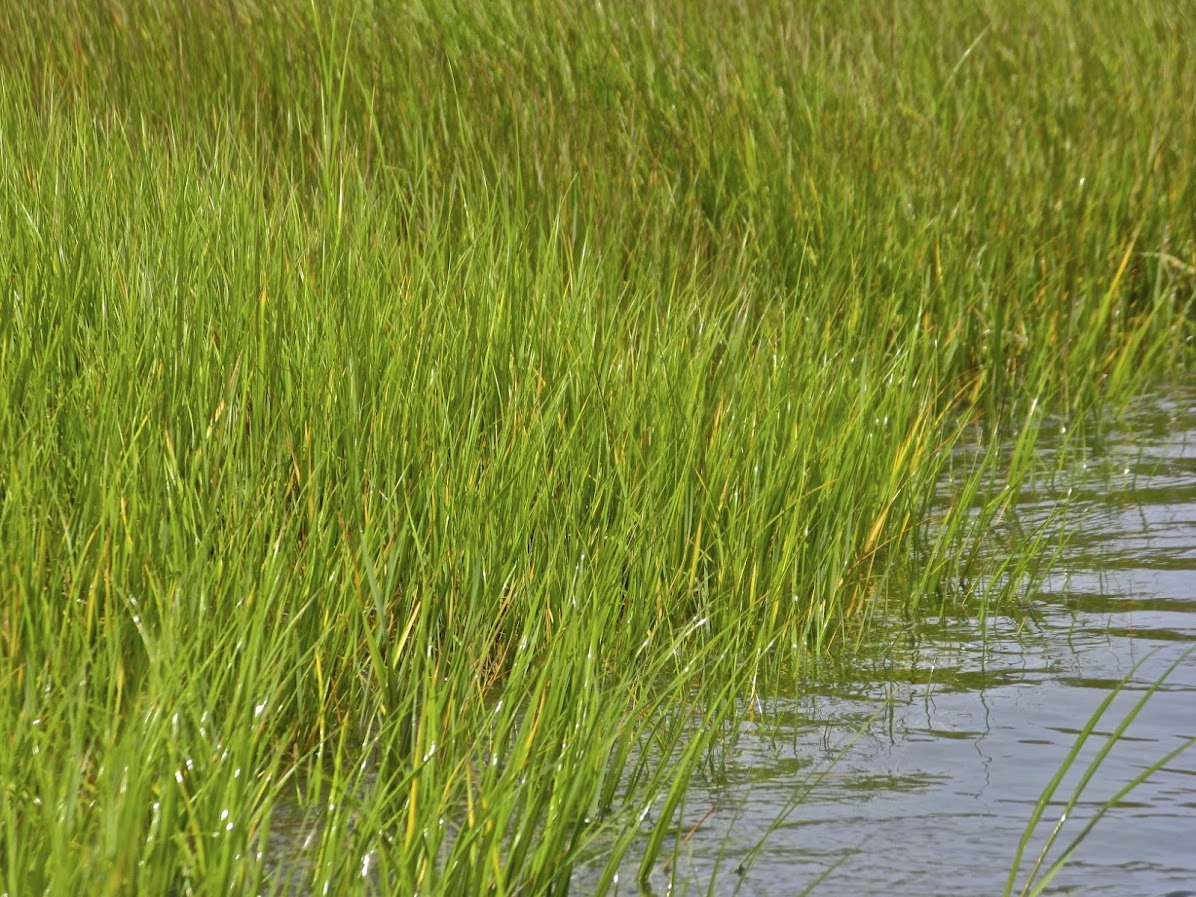
To gain a better understanding of climate resiliency, the research will investigate how long-term healthy marshes along Connecticut’s shore respond to projected temperature hikes compared to marshes that have been restored in the recent past. Secondly, it will look into whether, as temperatures rise, southern-sourced Spartina alterniflora, with genetic features and evolutionary history shaped by a warmer, southern climate, fare better than locally-sourced Spartina alterniflora, with the genetic features and evolutionary history suited to the northern climate.
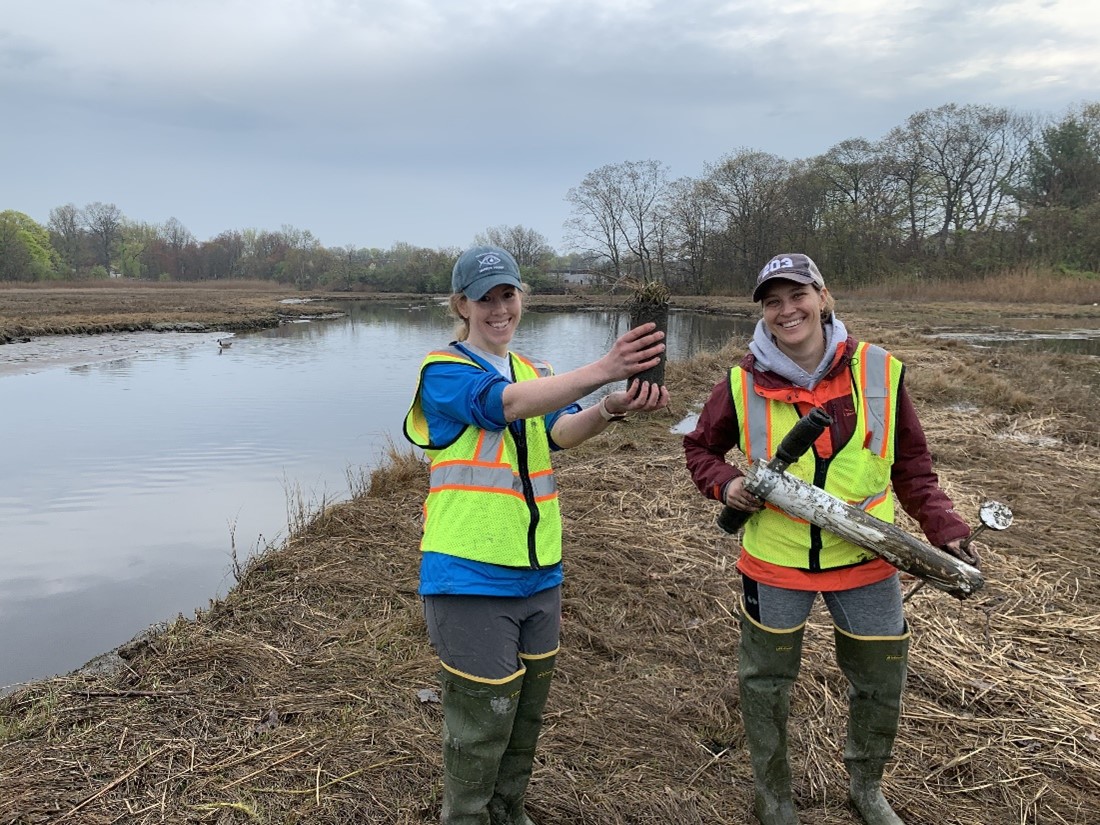
Spartina alterniflora, is the plant the research team, which besides Crosby includes Dr. LaTina Steele, an associate professor at Sacred Heart University, Dr. Randall Hughes, a professor at Northeastern University, and Nicole Spiller, the Director of Harbor Watch at Earthplace in Westport, CT is focused on. Also known as smooth cordgrass, the tall, slender grass inhabits the “low marsh,” the area of the salt marsh meadow closest to tidal waters where there is a daily occurrence of flooding. These grasses have a high tolerance for saltwater or brackish conditions. But in order to establish roots and survive in a wet and dry environment they are dependent on the buildup of sediment entering the marsh from daily tidal flow, as well as below ground biomass (from dead plants and organisms). The sediment and biomass must keep up with normal flooding and sea level rise. Any disruption to their habitat, such as increased sea level rise, can put their survival in jeopardy, and they will be forced to adapt, or die out.
Survival of the Fittest: Natural and Restored Marsh, Local-source and Southern-source Plants
To explore the potential effects of global warming on salt marsh plants, the research team selected eight sites across the Connecticut coast to observe and analyze Spartina alterniflora. Four of the sites are at long-established natural healthy marshes in the Sound: Oyster River and Gulf Pond located in Milford; the Bradford Preserve in East Haven; and Branford Harbor in Branford. The other four sites—the Great Meadows Marsh and Stratford Point in Stratford; the Housatonic River state boat launch in Milford; and the West River in West Haven—are restored marshes. Restored marshes are degraded marsh habitats that have been renewed by various managers and programs, including through the Long Island Sound Study’s Habitat Restoration Initiative.
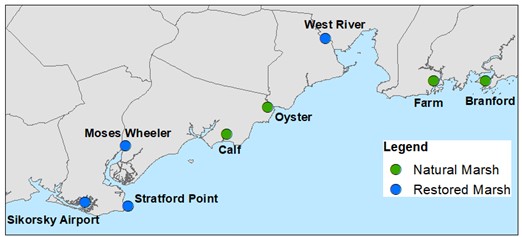
During the spring of 2023, the team assembled several enclosures called warming chambers at each of the sites to simulate what the temperatures would be like for the plants in the coming decades. Using PVC pipes to create a cube-shaped base structure, the team enclosed plots (small areas of vegetated habitat being measured by the researchers) of Spartina alterniflora within these open-top chambers. The chambers were made by wrapping the PVC base in thick, greenhouse-grade plastic sheeting on each side of the cube. On the top sheet of plastic sheeting, a hole is punctured in the center to permit precipitation into the plot. The grasses at restored marsh sites, planted within the last 10 years, will be compared to their natural marsh counterparts. Prior research on Connecticut marshes done by Crosby and her team has highlighted differences between natural and restored marsh. The study demonstrated that below ground biomass assembling under the surface of salt marshes is holding up better in natural marshes than in restored marshes. That being said, other findings also demonstrate that restored marshes have higher levels of genetic diversity, an advantage for a species facing imminent changes to the environment it is accustomed to, like rising temperatures.

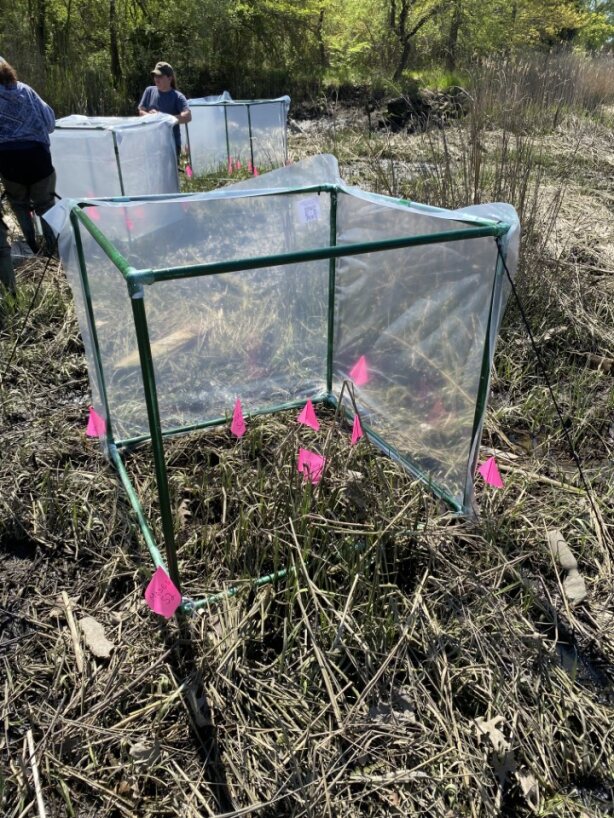
“You have a greater chance that one of those genotypes is well suited for the conditions that are about to happen,” said Crosby. Whether climate change warming will advantage one kind of marsh over another—and what methods or features can be adopted from one to use in another—will be explored using the data from the study.
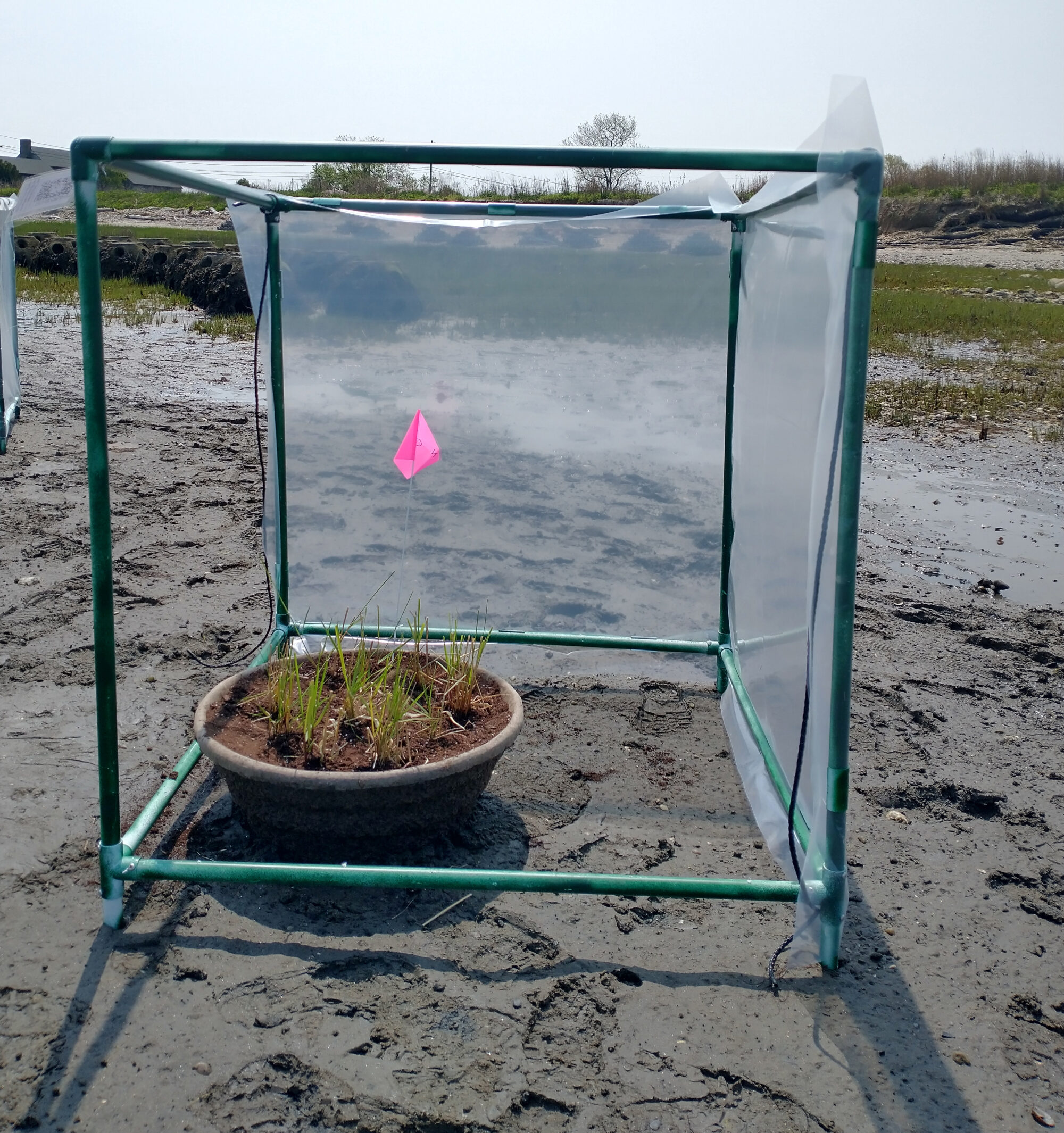
Set aside from the other seven locations, at the Stratford Point site, 18 experimental plantings were set up within the sand where Spartina alterniflora is growing, adjacent to the salt marshes. The research team has set these potted plants to house local, Connecticut-sourced plants as well as southern-source plants, in a combination of mixed and separate (i.e., local or southern-source only) plots. The potted plants will be used to observe differences in locally sourced and southern-sourced plants’ response to the heating temperatures. The southern-sourced plants, taken from nurseries in South Carolina and Florida, will be removed at the end of the study, to avoid unintended consequences related to introducing nonnative species to the Stratford Point marsh habitat.
The data collected from these experiments will provide information for Crosby and the rest of the research team to assess how global warming influences the growth of salt marshes, as well as its impact on their ability to store carbon. They are also interested in observing how the warming they simulate might change the allocation of biomass in a saltmarsh’s grasses—either increasing its biomass, decreasing it, or having no effects and maintaining the same amount of biomass pre-predicted global warming temperatures. According to Crosby, such effects are indicated by changes in the roots and stems of Spartina alterniflora, like their height, density, and diameter. “Some of those things may change because of some of the differences we see with latitude in these species, and how the plants grow slightly differently down south versus up here,” she said.
Biomass is just one characteristic that impacts the resilience of salt marsh plants, their capacity to endure significant changes to their environment.
“Not drowning under sea level rise; continuing to provide the habitat that we want them to; continuing to protect our soil from erosion,” said Crosby, listing some of the key and of resilience. The survival of the marsh at large ultimately hinges on the survival of the plants, like Spartina alterniflora, that they are founded on.
Gaming the Gene Pool: Exploring genetic adaptation to rising temperatures
As the investigators continue their work in the field, which will be ongoing through the fall of 2024, another segment of the project is taking place at a greenhouse and laboratory at Northeastern University in Boston. Led by geneticist Randall Hughes, researchers are studying the DNA of southern and locally-sourced plants to understand the role that genetics may play in the changing climate landscape for Spartina alterniflora and the marshes they grow.
The scientists are using DNA sequencing technology on leaf-tissue samples to examine the characteristics of the naturally growing healthy marshes, restored marshes, and plants sourced from northern and southern greenhouses to gain a better understanding of how genetic makeup favors or hinders their ability to survive under the temperatures anticipated in coming decades. They also hope to identify opportunities for breeding between local and southern-source plants that may increase adaptive potential, or resilience, through the production of offspring with the most “resilient set of genetics.” A question remains, however, about whether differences in the timing of flowering will prevent such mixing.
Fortifying Our Marshes
As the team continues the data collection phase of the project, Crosby expresses her hopes for the application of the findings of the study to boost the resilience of the Sound’s salt marshes and “translate into different management of these ecosystems.”
Salt marshes have an important, multifaceted identity in the Long Island Sound as habitats, carbon reservoirs, and natural protectors of shorelines and residential areas from increasingly destructive coastal storms. Crosby’s research helps to support the larger goal of Long Island Sound Study restoration efforts.
The goal is that the findings will reveal “whether there’s something we can do, that’s as simple as buying our plants from a different place that might actually make a difference,” said Crosby. “There’s a lot of potential applicable pieces of information that we’re hoping will come out of this.”
Juanita Asapokhai was a Communications Intern for the Long Island Sound Study in summer 2023. She attends Tufts University and will be graduating with degrees in Community Health and Sociology in the spring of 2024.
A multifaceted ecological superstar built to survive daily flooding on the coastal edge faces new stresses with climate change
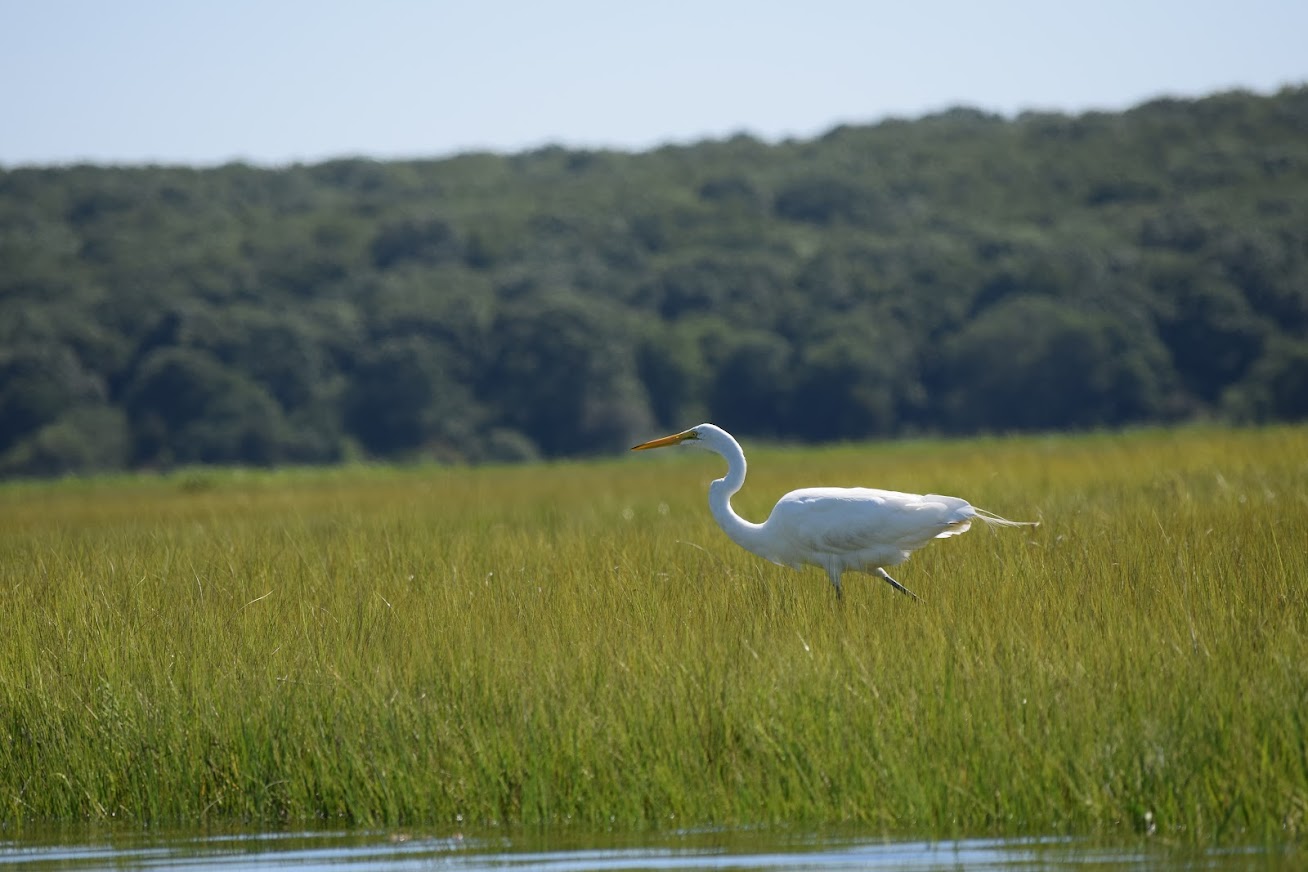
By Juanita Asapokhai
Salt marsh meadows, also known as tidal marshes, grow from the long-term accumulation of plants such as Spartina alterniflora and sediment close to the shore. This growth is dependent on maintaining a balance between the periods of wetness and dryness caused by high tide and low tide that allows the plants and sediments to amass enough material to form the marsh. The ability of salt marsh to withstand fluctuations in sea level is essential to their survival. As global warming causes sea levels to rise, this balance is in jeopardy, and salt marsh plants like the Spartina alterniflora, also known as smooth cordgrass, will be forced to adapt, or die out. The worst outcomes of rising temperatures are still decades away, but, thanks to this research study funded by the Long Island Sound Study (see main story), researchers are seeking to get a better understanding of long-term impacts.
The role of the salt marsh in Long Island Sound’s ecosystem is multifaceted, with a long environmental history as a habitat for various species, and a historical and contemporary asset in the lives of Long Island Sound communities.
A visit to a beach or shoreline in the Sound with a thriving salt marsh will quickly showcase sprawling patches of Spartina alterniflora stretching up out of the water, not too far away from sediment and sand in the low marsh. A long, slender grass, Spartina alterniflora, also known as smooth cordgrass, is the foundation species of salt marshes in the Sound. The grass provides the base material that, over time, integrates biomass —plants and their petals, stems, roots, and other organic materials —with sediment to form the mass of salt marsh. In comparison with other “high” or upland marsh plants, Spartina alterniflora is particularly tolerant of the flooding brought by high tide, as the surface of the marsh and part of the plant is underwater. The optimal conditions for the growth of salt marsh occur within the intertidal zone. The intertidal zone refers to the cycle between wetness (as well as exposure to saltwater) and dryness directed by the tides that enables salt marsh to pace sea level rises by growing tall enough to avoid being submerged beneath the water too frequently.
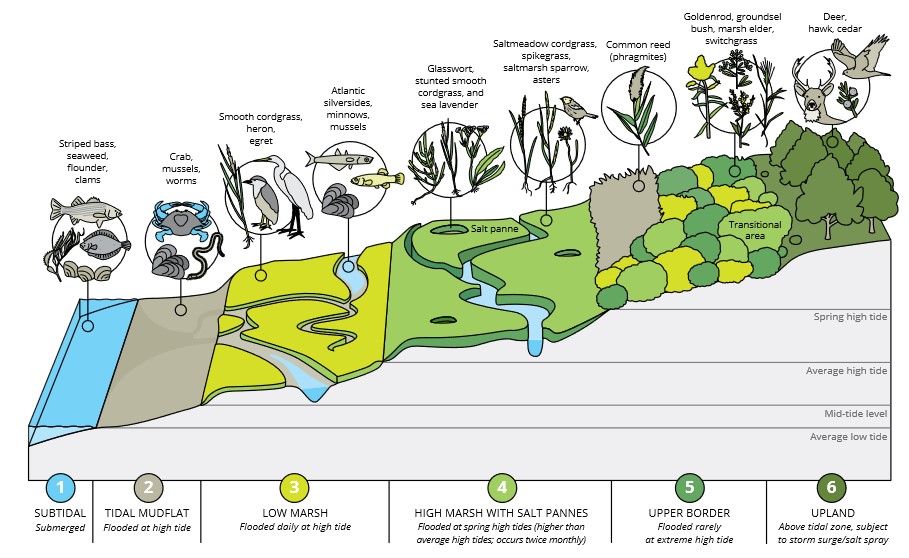
The underground system of roots and material of plants like Spartina alterniflora enable salt marshes to function as effective nutrient sinks. Absorbed by the marsh plants through photosynthesis and by their roots, nutrients like carbon, nitrogen, and phosphorus accumulate in the below ground biomass for a long period of time, removing them from the Sound and the atmosphere. This is a particularly valuable feature of salt marshes in the case of carbon, a greenhouse gas.
Salt marshes play host to a variety of coastal birds. Ospreys and their nests are easily spotted close to these estuary habitats. Marshes are also a breeding ground for willets, a once-endangered species that, thanks to conservation efforts started in the 1970s, has since seen a significant boost in its numbers in the past few decades. The great blue heron, whose uniquely webbed feet allow them to navigate the muddy terrain of salt marshes with ease, lives on salt marshes throughout the year. Salt marshes support the broader food chain of the Long Island Sound by providing a habitat for fish like the mummichog and striped killifish that serve as food for species that dwell offshore. The juvenile offspring of horseshoe crabs and American eels reside within marshes until they have matured, at which point they move offshore. The biodiversity preserved and sustained by salt marshes makes them an essential fixture in the ecology of the Long Island Sound.
For communities of Long Island Sound, salt marshes have had several important roles throughout history. Precolonial indigenous cultures utilized salt marshes for fishing and farming for hay. The salt marshes present across the Sound today are a fraction of preexisting marshes, a large percentage of which have been eliminated for coastal development in the form of roads and residences. As homes continue to populate the coast and shorelines, the presence of salt marshes is needed now more than ever to act as a buffer for flooding and storm damage. When high-energy waves push water onto the shore, salt marsh vegetation such as Spartina alterniflora reduces the energy of the waves by providing friction, slowing the waves’ momentum and force on the shore and the homes beyond it. The below ground biomass of salt marshes helps to retain the position of the coastline and resist erosion due to storm waves.
The ecological conditions needed for this “vertical” growth are in jeopardy: as rising sea levels push salt marshes farther up the shore, where they run into developments on the Sound, like roads and train tracks. Further, as sea levels rise, the plant’s high tolerance for a wet environment has led to the creep of the species into higher marsh areas, where flooding is less frequent, and that serve as habitats for species, like the endangered salt marsh sparrow. Salt marsh conservation and restoration efforts are important steps to mitigating the projected effects of rising sea levels on the salt marsh ecosystem of the Long Island Sound and the various species that call marshes home.
The ability of the salt marsh meadows to withstand fluctuations in sea level is essential to their survival. The worst outcomes of rising temperatures are still decades away, but, research projects such as a 2022-fund project through the Long Island Sound Study Research Grant Program are providing decision-makers with information on how get a better understanding of long-term impacts and plan for the future.
Juanita Asapokhai was a Communications Intern for the Long Island Sound Study in summer 2023. She attends Tufts University and will be graduating with degrees in Community Health and Sociology in the spring of 2024. Dr. Sarah Crosby, Director of Conservation and Policy at The Maritime Aquarium at Norwalk, provided information about salt marshes for this article.
This announcement was updated on Oct. 12, 2023 to include registration links for eastern Connecticut and Westchester.
Save the Date for 2nd Annual Sustainable & Resilient Communities Bi-State Workshop
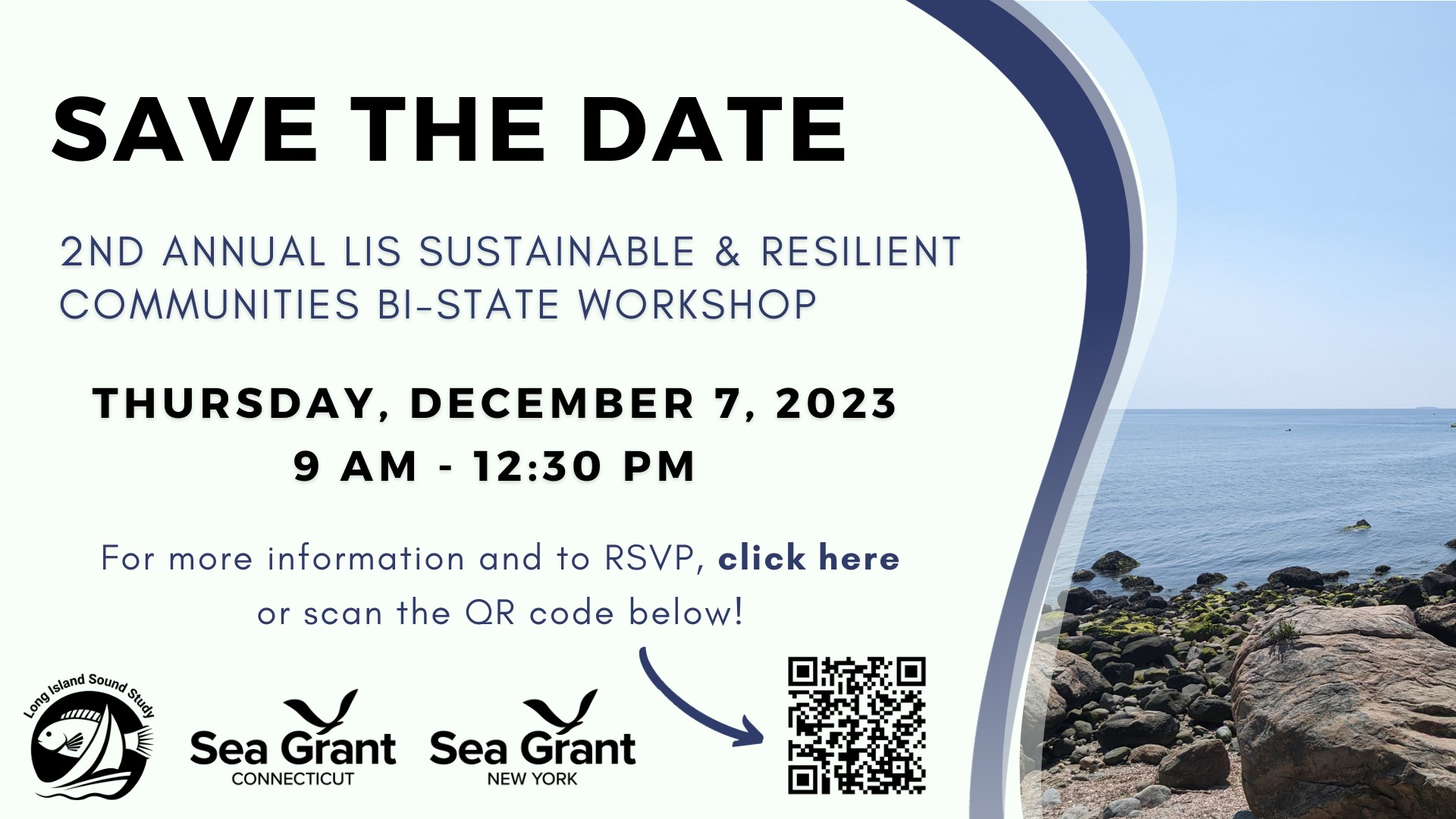
Last year, more than 260 people attended the first Annual SRC Bi-State Workshop to learn about opportunities to increase the resilience of Long Island Sound communities to impacts from a changing climate and other environmental threats. This fall, extension professionals from the Connecticut and New York Sea Grant Programs, in conjunction with Long Island Sound Study, will once again host a half-day virtual workshop on Dec. 7 from 9 am to 12:30 p.m. to bring together local government, Indigenous, tribal, and community leaders, nonprofits, and other stakeholders from around the Sound. This year’s workshop will focus on debuting a new Long Island Sound Resilience Resource Hub website and providing information on resilience planning and implementation.
Please save the date and register here.
More information to come. For questions email lisresilience@gmail.com.
Join Us in November for a Resilience Excursion!
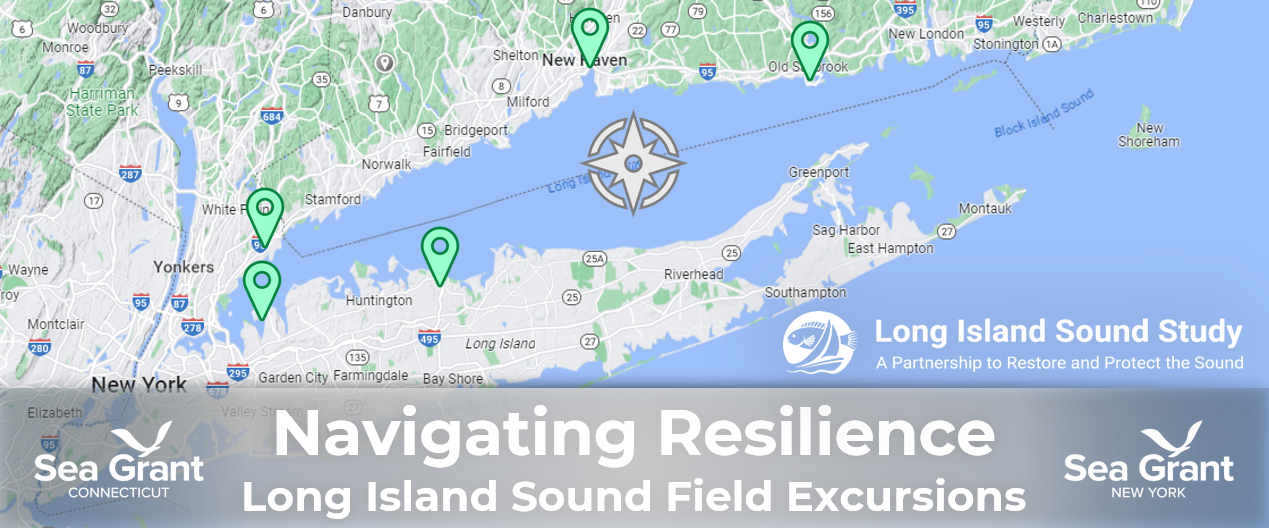
Leading up to their annual workshop, this November, the Sustainable and Resilient Communities extension professionals are hosting field excursions around Long Island Sound to showcase community resilience projects. This series of field trips offers a unique opportunity for communities to connect and learn from each other and inspire increased implementation of resilience projects throughout the region. We encourage you to attend as many field excursions as you can and explore the Sound!
Included: Refreshments will be provided at all field excursions. For those that don’t have travel budgets through their employers, we can reimburse travel expenses up to $150/person/field excursion.
Secure your spot today by registering below to one or more of our events. Registration is required for all field excursions. See below for more information on each and to register. Note that registration needs to be finalized for Eastern Connecticut and Westchester County field excursions. Check back to this announcement for updates.
Suffolk County: Sunken Meadow State Park, Kings Park, NY
Nov. 3, 2023 {10am–2:30 PM}
View and discuss green infrastructure projects and ongoing marsh restoration efforts. Register here by Oct. 26.
Western Connecticut: New Haven, CT
Nov. 8, 2023 {10Am–2pm}
Explore various green infrastructure projects around New Haven. Register here by Oct. 31.
Eastern Connecticut: Fenwick, CT
Nov. 9, 2023 {11:30am–2:30pm}
View and learn about the Fenwick living shoreline project. Register here by Nov. 1.
Nassau County: Manorhaven, NY
Nov. 15, 2023 {10AM–2PM}
Learn about Town of North Hempstead Climate Smart Communities actions and local oyster restoration work. Register here by Nov. 8.
Westchester County: Rye, NY
Nov. 17, 2023 {10AM–2PM}
Learn about different resilience projects and planning activities happening in the Blind Brook watershed. Register here by Nov. 9.
Long Island Regional Planning Council offers ‘Garden Rewards’ grant program for homeowners to reduce runoff and nitrogen pollution
In early May 2023, the Long Island Regional Planning Council announced the Garden Rewards Program for Long Island homeowners (see news release below). The Long Island Sound Study provided additional funding to this program for eligible residents on the North Shore (residents who live in the Long Island Sound watershed). This additional money helps to increase the capacity of the program.
The program is off to a good start. See the update at the bottom of the page.
Up to $500 available to individual homeowners to install rain barrels, rain gardens and native plantings
Syosset, NY – [May 1, 2023] – Long Island homeowners looking to play a role in reducing stormwater runoff, which is one of the leading causes of nitrogen pollution in our waterways, will soon be eligible for grants to help cover the cost and maintenance of runoff mitigation projects on their property.

The Long Island Regional Planning Council (LIRPC), in partnership with the New York State Department of Environmental Conservation (DEC) and NEIWPCC, is introducing the Long Island Garden Rewards Program which will provide up to $500 to offset the expense of installing green infrastructure on their properties including rain barrels, native plantings, and rain gardens.
“The quality of our surface waters, and of our drinking water beneath us, is threatened by excess nitrogen pollution created by stormwater runoff,” stated John Cameron, LIRPC Chairman. “While municipalities on every level are addressing stormwater runoff and nitrogen pollution, the Long Island Regional Planning Council saw the need to encourage homeowners to become a part of the solution in their own small but significant way.”
Excess nitrogen causes toxic algal blooms that lead to low oxygen conditions, fish kills, harmful algal blooms, degraded wetlands and marine habitats. Nitrogen also contaminates the groundwater, which is the sole source of Long Island’s drinking water supply.
DEC Commissioner Basil Seggos said, “DEC is committed to protecting Long Island water quality in partnership with the Long Island Regional Planning Council, NEIWPCC, and Nassau and Suffolk counties. Reducing nitrogen pollution is critical to improving water quality, protecting groundwater, and strengthening the long-term health of marine life. DEC encourages homeowners to take part in the Long Island Garden Rewards Program and talk to neighbors about how green infrastructure can reduce runoff and protect the environment.”
“It has been great working with LIRPC and NYSDEC to build out this program, and I’m excited for this launch!” said Courtney Botelho, NEIWPCC Environmental Analyst. “The program offers Long Island residents a hands-on opportunity to meaningfully contribute to local water quality improvements right from their yards.”
Under the Long Island Garden Rewards Program, homeowners can receive a maximum of $500 to help cover the cost of their projects.
Rain Barrels: Rain Barrels reduce stormwater runoff by collecting and storing rainwater for homeowners to later use in their yards and gardens, also helping conserve water consumption. Barrels must be a minimum of 50 gallons and are required to have mosquito netting or screening. Reimbursement of up to $125 for each barrel will be provided for purchase, up to $500 maximum.
Native Plantings: Native plants are heartier and more resilient to local climate conditions. Native plant plantings can reduce water usage, reduce fertilizer and pesticide usage, and promote biodiversity. These native plants help promote a healthy ecosystem and are more resistant to local weather.
Rain Gardens: Rain gardens collect rainwater from roofs, driveways and other surfaces and allow that rain to soak into the ground. Rain gardens can filter stormwater before it reaches local waterways, mitigate flooding caused by pavement and enhance your yard with low maintenance landscaping. To be eligible, a rain garden must be a minimum of 20 square feet, use native plants and be maintained for at least three years.
For more information on the Long Island Garden Rewards CLICK HERE.
About Long Island Regional Planning Council
The Long Island Regional Planning Council comprises public and private sector leaders who are experienced and knowledgeable in business, environment, transportation, and planning. Its mission is to educate Long Island officials, stakeholders and residents on key issues affecting the quality of life in the region, and to propose immediate and long-term strategies and solutions.
Update (Oct. 4, 2023)—The Long Island Garden Reward Program is off to a good start. As of Oct. 2, a total of 195 Long Island residents, including 80 residents in the Long Island Sound watershed, received up to $500 this summer and fall to offset the expense of installing native plants, rain gardens, and rain barrels in their yards. The commitment from these homeowners benefits all Long Islanders by helping to reduce stormwater runoff, which is one of the leading causes of nitrogen pollution in local waterways. The program is expected to continue next year.
# # #
The extension professionals of the Connecticut and New York Sea Grant Programs, through the Sustainable and Resilient Communities initiative, have made available their “Steps to Resilience” webinar. The online information session held Sept. 19, and repeated Sept. 21, provides an introduction to resilience planning in the Long Island Sound region. It includes discussions on local climate impacts and projections, resilience planning strategies, and climate certification programs for both New York and Connecticut municipalities.
The webinar is posted on YouTube. In addition to the main presentation, videos of Connecticut and New York breakout sessions, also posted on YouTube, can be accessed below. The presentations and other resource materials are available as a PDF in Google Drive.
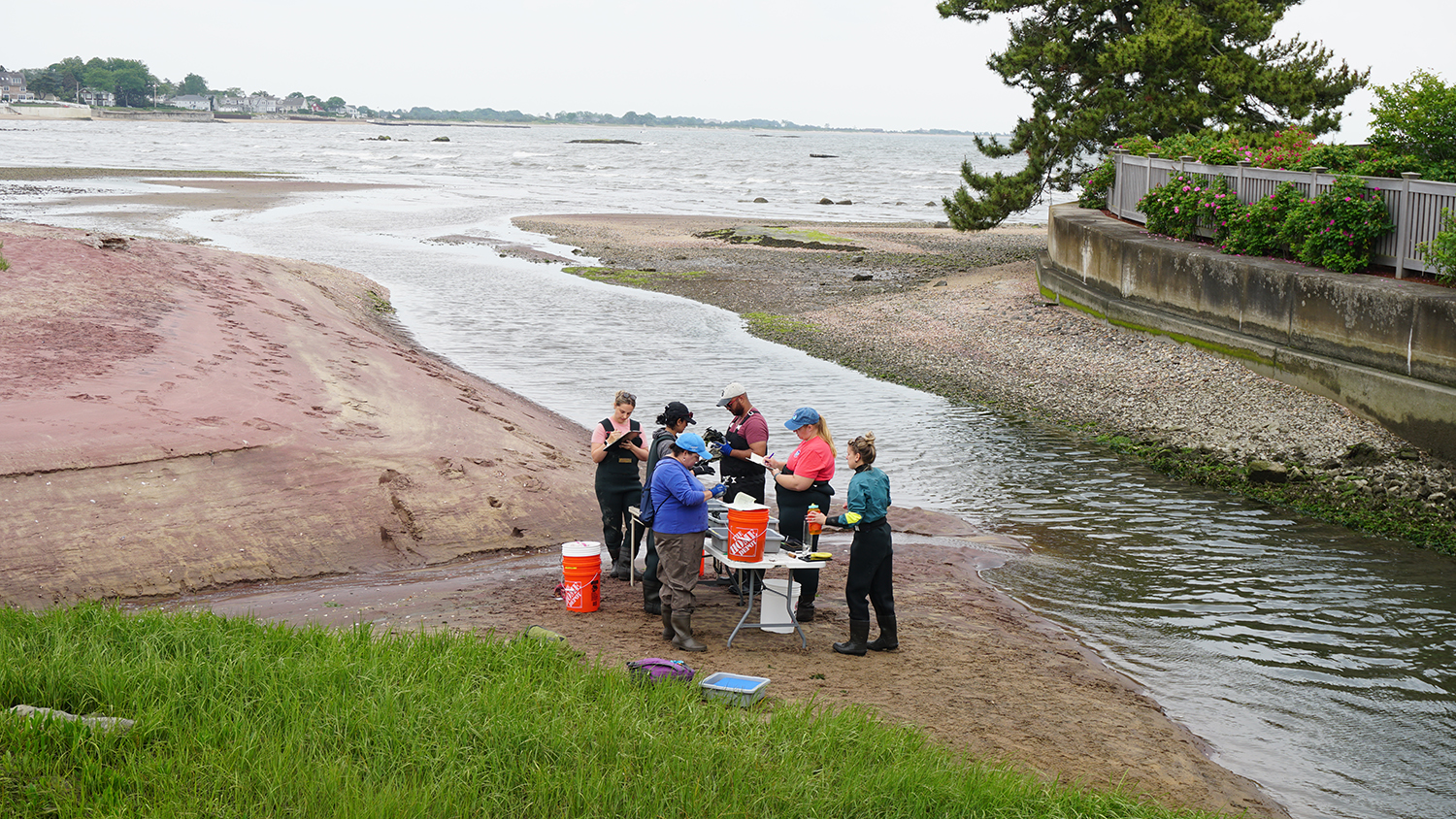
Expanding natural oyster populations can benefit people and the environment. However, scientists do not know how unmanaged oyster populations affect the spread of oyster disease in Long Island Sound. To gain a better understanding, the Long Island Sound Study Management Committee in 2022 provided $1.27 million to the NOAA Milford Lab to collect baseline data for an assessment of disease dynamics of natural and restored oyster beds in Long Island Sound. Working with local partners, NOAA is taking a comprehensive look at oyster population health in natural and restored oyster populations.
NOAA is assessing the health of oysters at four sites monthly over multiple years. Two sites are in Connecticut, one at Ash Creek in Fairfield, and the other at Fence Creek in Madison. The other two sites are on the north shore of Long Island at Cold Spring Harbor and Huntington Harbor.
To learn more about the project, which is being led by Meghana P. Parikh, a veterinarian focused on animal production health, and Katie McFarland, a shellfish biologist, visit the NOAA website. Also, check out a blog post from Mariah Kachmar, a shellfish health and disease technician at the NOAA Milford Lab, who is on the project research team.
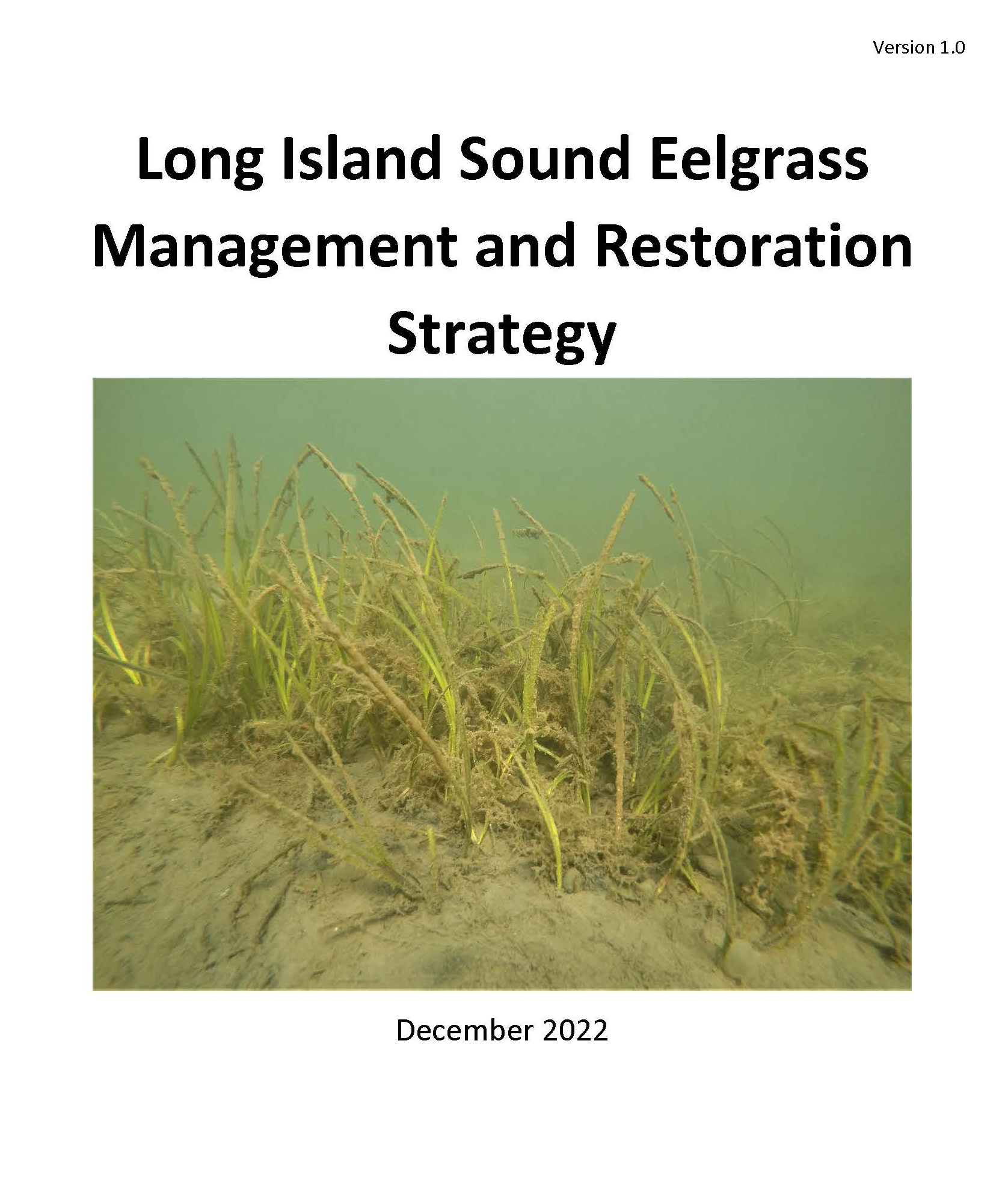
The Long Island Sound Eelgrass Management and Restoration Strategy provides guidance for short and long-term actions that should be taken to manage and restore eelgrass meadows in Long Island Sound and act as a resource for other estuaries in the region facing similar issues. The strategy is a living document, meaning that as new research, resources, and information becomes available, the gaps and required actions may change. It was developed by the EPA Long Island Sound Office in collaboration with the Long Island Sound Study and local expert and stakeholder input.
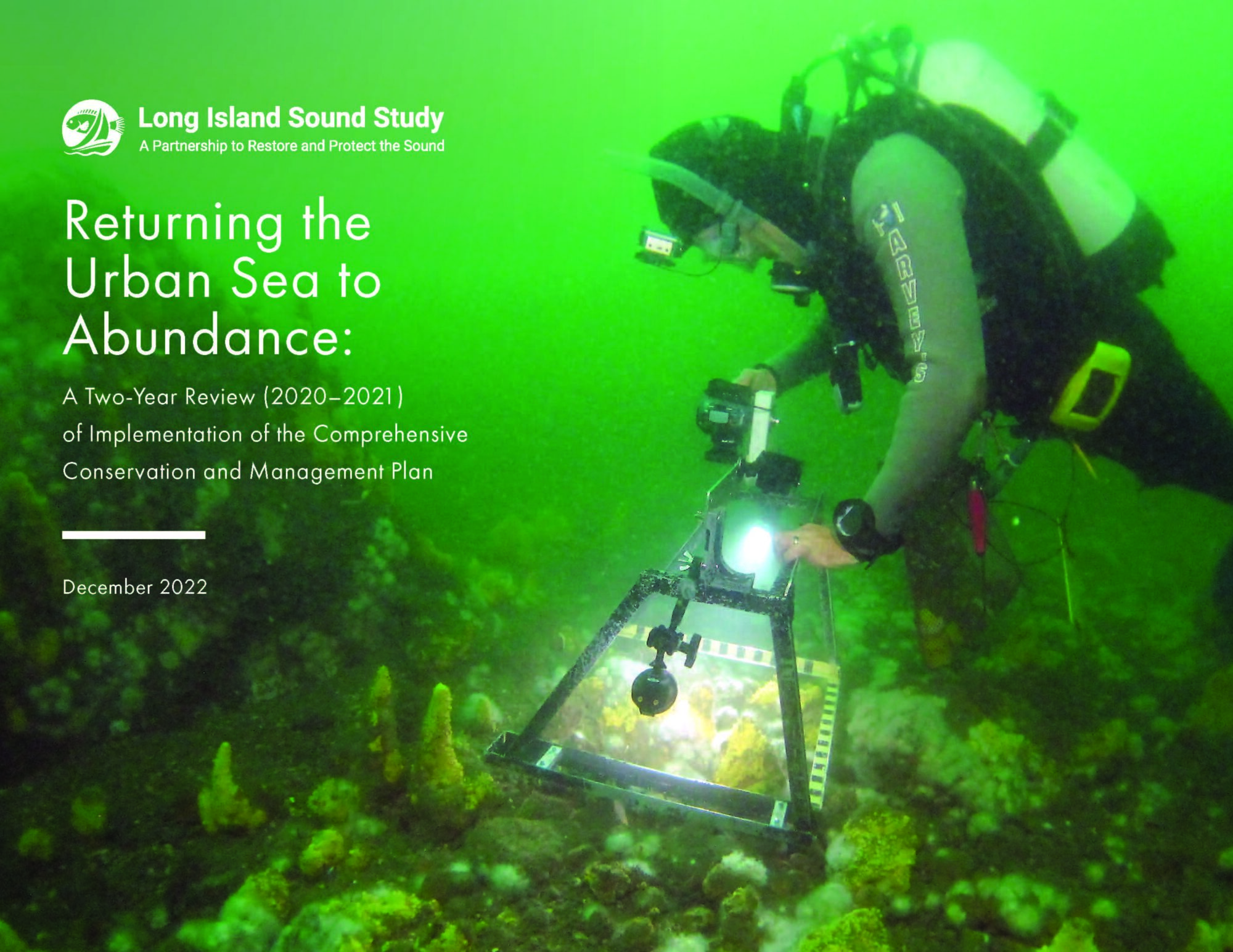
Returning the Urban Sea to Abundance (2020-2021) is a Congressionally authorized two-year review of implementation of the Long Island Sound Study Comprehensive Conservation and Management Plan. It builds upon the previous Returning the Urban Sea to Abundance report, which summarized progress made from 2015 to 2019 by the Long Island Sound Study under the CCMP.
Read the document.